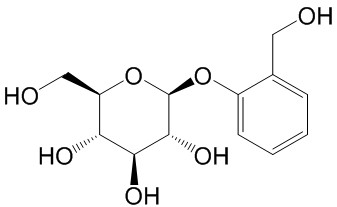Home
Products
D-(-)-Salicin



| Product Name | D-(-)-Salicin |
| Price: | $15 / 20mg |
| Catalog No.: | CN04113 |
| CAS No.: | 138-52-3 |
| Molecular Formula: | C13H18O7 |
| Molecular Weight: | 286.27 g/mol |
| Purity: | >=98% |
| Type of Compound: | Phenols |
| Physical Desc.: | Powder |
| Source: | The peels of Salix alba L. |
| Solvent: | DMSO, Pyridine, Methanol, Ethanol, etc. |
| SMILES: | OC[C@H]1O[C@@H](Oc2ccccc2CO)[C@@H]([C@H]([C@@H]1O)O)O |
| Contact us | |
|---|---|
| First Name: | |
| Last Name: | |
| E-mail: | |
| Question: | |
| Description | Salicin is a natural COX inhibitor. |
| Target | COX |
| In Vitro | Significant down regulation of PGE2, the enzymatic product of COX2, to 76% in lysate and 70% in supernatant is observed with Salicin 10 μM treatment in COLO cells when compare to the COLO control. This is accompanied with a minimal COX1 inhibition to 91% of the CCD control on the genetic level. Treatment with Salicin 1 μM decreases colon cancer cell proliferation rates from 144% to 113% at 24 hours and 187% to 130% at 48 hours, with 10 μM decreasing proliferation rates to108% at 24 hours and 119% at 48 hours[1]. The concentrations of TNF-α, IL-1β and IL-6 of LPS-induced cells pretreated with 0.07, 0.14 and 0.28 μM Salicin are significant reduced compare with LPS group[2]. |
| In Vivo | Salicin (D(-)-Salicin) (35, 70, 140 μM) markedly inhibits the LPS-induced pathological changes. MPO activity in LPS-induced lung tissue is significantly increased compare with control group. However, Salicin (35, 70, 140 μM) markedly inhibits this change. Pretreatment with Salicin inhibits LPS-induced activation of JNK, ERK, p38/MAPK and p65 in a dose-dependent manner[2]. |
| Cell Assay | RAW264.7 mouse macrophage cell line is used in this study. RAW264.7 cells are mechanically scraped and plated at a density of 4×105 cells/mL onto 96-well plates in a 37°C, 5% CO2 incubator for 1 h. Then the cells are treated with 50 μL Salicin (D(-)-Salicin) of different concentrations (0 to 0.28 μM) for 1 h, followed by stimulation with 50 μL Lipopolysaccharide (LPS) (4 μg/mL). After 18 h, 10 μL CCK-8 is added to each well and continued to incubate for 4 h. Then, the optical density is measured at 450 nm on a microplate reader[2]. |
| Animal Admin | Mice are randomly divided into five groups, each containing three mice: Control, Lipopolysaccharide (LPS) only, LPS+Salicin (D(-)-Salicin) group is injected intraperitoneally with Salicin 35 μM, LPS+Salicin group is injected intraperitoneally with Salicin 70 μM, LPS+Salicin group is injected intraperitoneally with Salicin 140 μM. After 1 h, 10 μg LPS dissolved in 50 μL PBS is instilled intranasally to induce lung injury. Control mice are given 50 μL PBS without LPS. After 12 h LPS treatment, bronchoalveolar lavage fluid (BALF) is collected 3 times through a tracheal cannula with autoclaved PBS. Then, the tissue sample is centrifuged at 3000 rpm, for 10 min at 4°C[2]. |
| Density | 1.5±0.1 g/cm3 |
| Boiling Point | 549.1±50.0 °C at 760 mmHg |
| Flash Point | 285.9±30.1 °C |
| Exact Mass | 286.105255 |
| PSA | 119.61000 |
| LogP | -1.85 |
| Vapour Pressure | 0.0±1.6 mmHg at 25°C |
| Storage condition | Store at RT. |